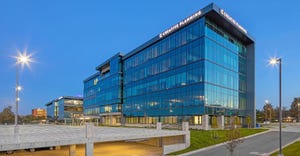Are Transload Facilities the Next Frontier in the Industrial Investment Race?Are Transload Facilities the Next Frontier in the Industrial Investment Race?
Truck terminals and transload yards are essential to supply chain efficiencies. Investors are beginning to notice.

The growing logistics industry has not only created insatiable demand for warehouse space, it has ramped up growth in the transportation industry, creating a need for modern truck terminals with high-volume flow-through facilities. Commercial real estate investors are beginning to take notice and are allocating more of their money to this niche sector.
“Historically, investors in truck terminals were large trucking companies that wanted to own their own facilities, like Old Dominion ABF, SAIA, R&L, Carriers, Central Transport and ESTES,” says Dean Brody, executive managing director and specialist in this investment area with real estate services firm JLL. Today, this sub-sector is attracting big institutional investors and industrial real estate developers/investors. These include Centerpoint, Realterm Logistics, Terreno Realty, Brookfield, Duke Realty, Prologis, Stonemont, Altera, JP Morgan and others that have recently entered this market. Speculative development may not be far behind.
For example, in April, Chicago-based Dayton Street Partners acquired a 17,897-sq.-ft. truck terminal near Tampa International Airport in Florida from a private investor for an undisclosed price. The property is 100 percent leased to ABF Freight. “This was a great opportunity to capitalize on increasing demand in the market and is part of a larger corporate strategy to invest in well-located, logistics-related real estate assets in Florida and throughout the U.S.,” said DSP Principal Michael Schack in a statement.
Integrated Service Provider (ISP) facilities are essential to supply chain efficiencies, Brody notes. Amid higher transportation costs and driver shortages, the need for them has been growing over the pst 15 years. The e-commerce boom has accelerated demand for those facilities by multiples, Brody says.
“The purpose for these buildings is either redirecting cargo mode—usually from container to truckload—or consolidating and redirecting freight direction and what freight rides together,” according to John Morris, executive managing director and Americas industrial and logistics leader with real estate services firm CBRE.
De-containerizing cargo and transloading it onto trucks or rail cars facilitates logistics efficiencies, according to Brody. He explains, for example, that cargo from three 40-foot containers can fit into two 53-foot truck trailers, and it is more cost-effective for those trucks to deliver the cargo than directly transporting it over 50 miles to the final destination because the empty containers then must be returned to the origination point.
Markets that see the heaviest cargo movements have the highest demand for these functionalities, Morris notes. For example, there is a significant density of transload buildings in Southern California’s Inland Empire, where cargo is often moved from the ports of Los Angeles or Long Beach, Calif. because it costs less to de-containerize it there than closer to the ports. “Containers coming in from China are dray-moved to these buildings, de-containerized into different trucks or rail cars and moved out to mostly points further east from there,” Morris says.
The fee revenue models for these facilities are similar to any real estate tenancy—users typically own or lease them, according to Morris. However, many are also third-party facilities, where users are charged through a 3PL arrangement that is a blend of fixed and variable costs. Brody notes that pricing is on a per-door, per-month triple-net basis.
ISPs are located in logistics hubs all over the country. Those near intermodal facilities and ports will have transload options, Brody says, noting that terminals in infill locations in places like Northern New Jersey, New York City outer boroughs, Chicago, Seattle, the San Francisco Bay area, Los Angeles and the Inland Empire are achieving the highest rents.
ISP property values are dependent on location, but cap rates on these assets tend to be on average 1.5 percent higher than those for class-A warehouse properties, according to Brody. He notes that the spread is narrowing in core markets, where cap rates on ISP assets are now only 50 basis points to 100 basis points higher than for a warehouse, or might even be the same.
While returns on investment for ISP facilities are lower than those for warehouse properties, Morris says that they are marginally less expensive to develop, as transloading buildings do not require much clear height, and their structures typically do not need to support heavy automation. Such buildings also have lower coverage ratios, typically about one-tenth of the site, but they do require a lot of land to accommodate the higher number of axles travelling in and out than a traditional warehouse does.
ISPs, which are basically concrete yards with a transloading facility, haven’t changed much over the last 50 years, except modern facilities have 100-foot dock doors as opposed to 70 to 90-foot doors found in older facilities, to provide greater flexibility in movement, Brody says.
Cities generally don’t allow the development of ISP facilities near large population centers, as they have several negative aspects: they are aesthetically unattractive and inherently involve heavy truck traffic and significant CO2 emissions. Therefore, Brody notes that there is tremendous value in land already zoned for ISPs.
Despite high demand for these facilities, they have traditionally been developed on a build-to-suit basis for single-tenant users, such as large Fortune 100 retailers or third-party logistics providers, including Fedex, UPS, XPO and National Retail Systems. But going forward, Brody expects that spec developers will soon begin capitalizing on the growing need for ISP buildings.
About the Author
You May Also Like







